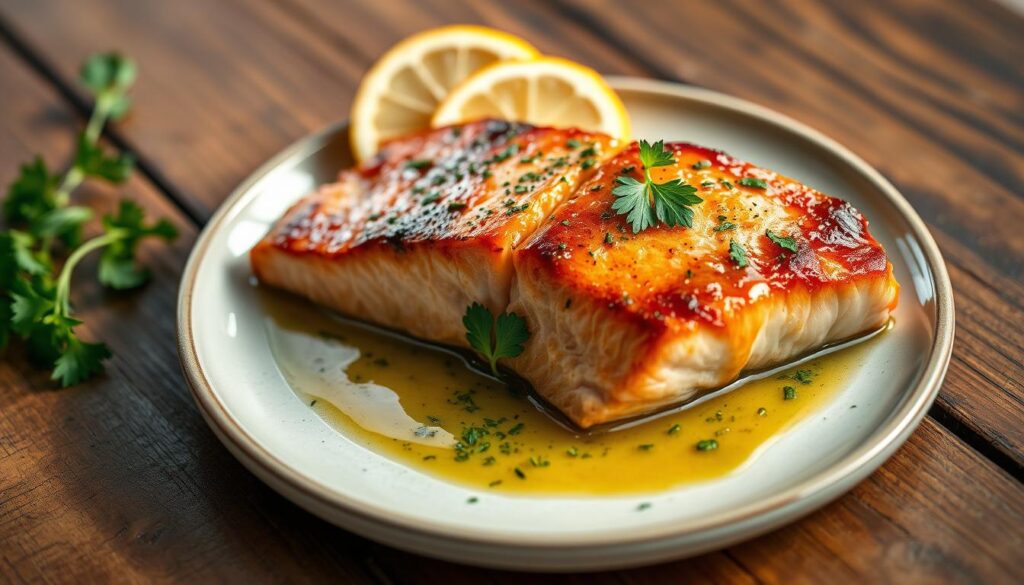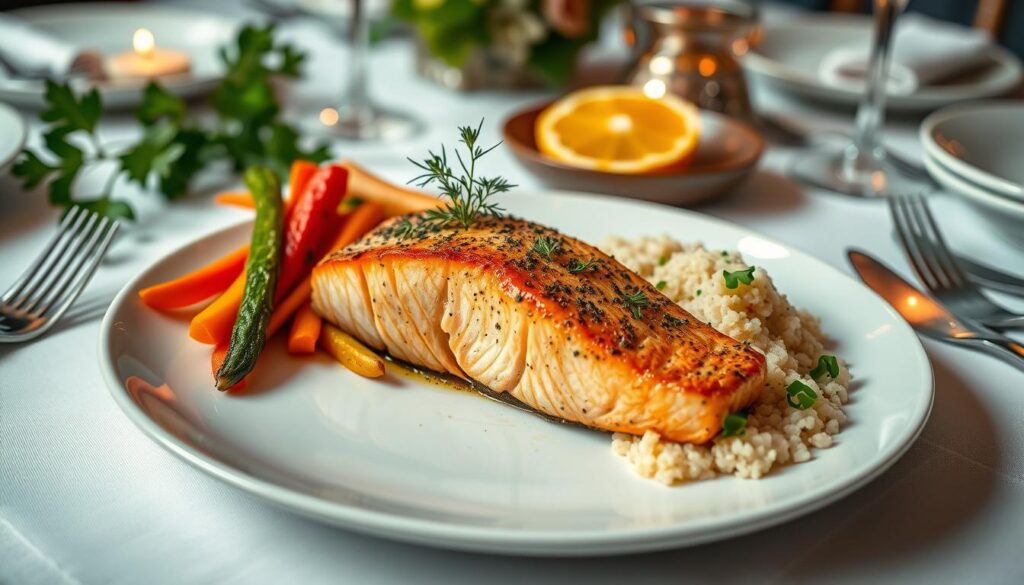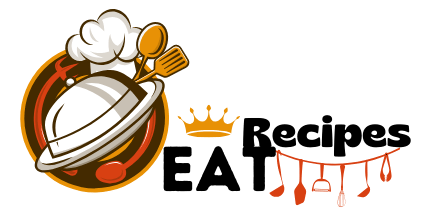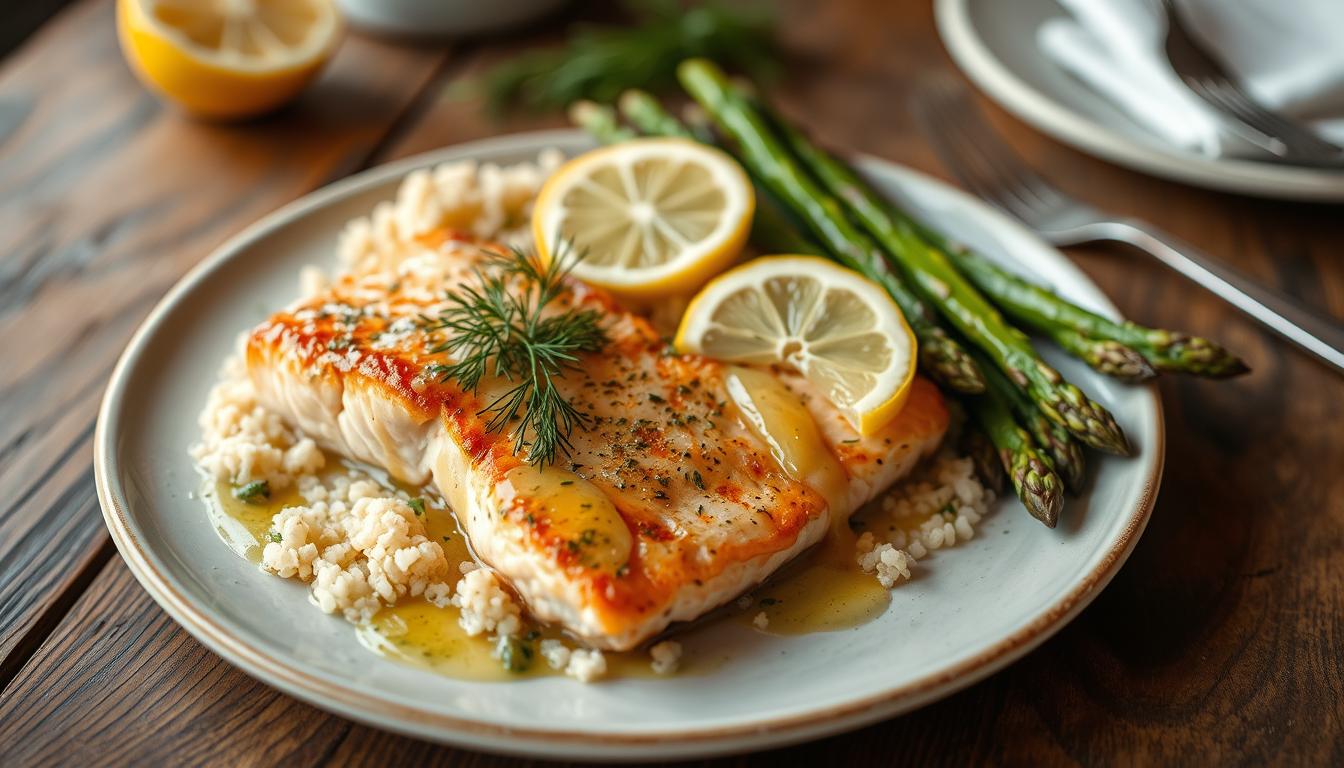Perfect Salmon Steak Recipe for an Easy Dinner
There’s nothing like the smell of a seared salmon steak in the kitchen. It makes me hungry and excited to share a recipe. This dish takes you to the Pacific Northwest, where the seafood is fresh.
In 15 minutes, you can make a salmon steak dinner that tastes like it’s from a restaurant. The secret is simple seasoning. Use sea salt, black pepper, and dried sage to bring out the salmon’s flavor.
Salmon is my favorite fish, and I choose it over others like cod or mahi mahi. It’s not only delicious but also very nutritious. That’s why it’s a top choice for those who care about their health.
Table of Contents
Key Takeaways
- Salmon steak recipe ready in just 15 minutes
- Savory seasoning of sea salt, black pepper, and dried sage
- Salmon is author’s personal favorite fish for its rich flavor and nutrition
- Recipe calls for basic, easy-to-find ingredients
- Salmon steaks are cooked to perfection in a skillet on the stovetop
Understanding Salmon Steaks vs. Fillets
Choosing between salmon steaks and fillets can greatly affect your dish. Knowing the differences between these cuts helps you pick the right one for your meal.
Key Differences in Cut and Structure
Salmon steaks are cut crosswise, including the bone, while fillets are cut lengthwise, away from the bone. Steaks have skin, while fillets are often skinless. Steaks have bigger bones than fillets, which are boneless and thinner.
Benefits of Cooking with Salmon Steaks
Salmon steaks have a heartier texture and keep moisture well. They’re great for grilling, roasting, and pan-searing. The bone and skin help keep the steak juicy. A good size for a steak is about 8 ounces, perfect for most people.
Choosing Between Steaks and Fillets
Think about your cooking method and taste when choosing between steaks and fillets. Fillets are better for gentle cooking like poaching and baking. They’re delicate. Steaks are best for high-heat methods like grilling and pan-searing. This gives them a crispy outside and juicy inside.
| Salmon Steaks | Salmon Fillets |
|---|---|
| Typically 1 inch thick for even cooking and moisture retention | Known for being leaner and more delicate in texture |
| Recommended for grilling, roasting, and pan-searing | Best suited for gentler cooking methods, like poaching and baking |
| Contain bone and skin, helping to maintain shape and juiciness | Boneless and often sold skinless |
The choice between salmon steaks and fillets depends on your taste and cooking method. Try both to see which fits your cooking style best.
Essential Ingredients for a Perfect Salmon Steak
Making a tasty salmon steak dish begins with picking the right ingredients. You’ll need fresh or thawed salmon steaks, olive oil, butter, garlic, and herbs like chives and parsley. For seasoning, use salt, black pepper, and a bit of dried sage, onion powder, and chili powder.
Choose salted butter for more flavor, but unsalted butter is okay if you’re watching your salt. Fresh herbs are best, but dried herbs work too if you don’t have them.
| Ingredient | Quantity |
|---|---|
| Salmon Steaks | 2 (8-ounce) |
| Olive Oil | 2 tablespoons |
| Butter | 4 tablespoons, salted |
| Garlic, minced | 2 cloves |
| Chives, chopped | 2 tablespoons |
| Parsley, chopped | 2 tablespoons |
| Salt | 1 teaspoon |
| Black Pepper | 1/2 teaspoon |
| Dried Sage | 1/2 teaspoon |
| Onion Powder | 1/4 teaspoon |
| Chili Powder | 1/4 teaspoon |
With these salmon steak ingredients, you’re ready to make a delicious, healthy fish meal that will wow everyone.
How to Select Fresh Salmon at the Store
When buying fresh salmon, knowing what to look for is key. This ensures you get the best quality. Whether you’re picking steaks or fillets, these tips will help you shop better.
Visual Inspection Tips
Choose salmon that’s bright pink or orange and shiny. Stay away from dull or discolored fish. The flesh should be firm and spring back when pressed.
Freshness Indicators
- Salmon should have a fresh, mild “ocean” scent, not a strong fishy odor.
- The eyes should be clear and bright, not cloudy or sunken.
- The gills should be a vibrant red or pink color, not brown or grey.
Storage Recommendations
To keep salmon fresh, keep it cold until cooking. Buy it last and store it in a cooler. Once home, refrigerate it right away and use within 3 days. Don’t let salmon sit at room temperature for too long, as it can spoil quickly.
| Salmon Type | Freshness Indicators | Recommended Storage |
|---|---|---|
| Fresh Salmon Steaks | Bright color, firm texture, mild ocean scent | Refrigerate for up to 3 days |
| Fresh Salmon Fillets | Vibrant color, moist appearance, no discoloration | Refrigerate for up to 3 days |
| Frozen Salmon | No freezer burn, package is airtight and intact | Freeze for up to 3 months |
| Canned Salmon | Cans are not dented, bulging, or rusted | Shelf-stable for up to 5 years |
By following these tips for selecting and storing fresh salmon, you can get the best quality. This will make your seafood shopping experience rewarding, with delicious salmon steaks or fillets.
Basic Salmon Steak Recipe
Make your dinner special with this easy salmon steak recipe. It’s healthy and delicious. Salmon steaks are great for a quick, tasty meal. They have a firm texture and strong flavor.
Start by getting your ingredients: four 6-ounce salmon steaks, 2 tablespoons of olive oil, and more. You’ll also need salt, black pepper, garlic, onion powder, and chili powder. Preheat your oven to 400°F (200°C) and line a baking sheet with parchment paper.
Pat the salmon steaks dry with a paper towel. Then, drizzle olive oil over them and spread it evenly. Mix the salt, black pepper, garlic, onion powder, and chili powder in a bowl. Rub this mix on both sides of the salmon steaks.
- Put the seasoned salmon steaks on the baking sheet, leaving space between them.
- Bake the salmon in the preheated oven for 12-15 minutes, until it’s cooked through.
- Let the salmon rest for a few minutes before serving. This helps the juices spread evenly.
Serve your easy salmon recipes with your favorite sides. Try roasted vegetables or a fresh salad. The baked salmon steak will impress everyone. It’s a quick, healthy meal with great flavors and textures.
Preparing Your Salmon Steak for Cooking
Before you cook your salmon steaks, there are a few key steps. First, pat the steaks dry with paper towels. This removes excess moisture, helping the seasoning stick better and preventing steaming.
Next, check the steaks for small bones. Removing these will make your meal smoother and more enjoyable.
Seasoning Methods
Now, it’s time to season your salmon steaks. You can use a simple mix of salt, pepper, and dried sage. Or, for a richer flavor, try garlic powder, onion powder, and chili powder. Rub the seasoning on both sides of the steaks for even coverage.
Temperature Considerations
Before cooking, let your salmon steaks come to room temperature. This ensures even heat when cooking, leading to perfectly cooked fish. Preheat your oven to 400°F for baking or a skillet over medium-high for pan-searing.
With your salmon steaks prepped, you’re almost ready for a delicious meal. Next, we’ll look at the best ways to cook and the timing for the perfect salmon steak.
Cooking Methods and Timing
Preparing salmon steaks can be done in several ways. You can bake, pan-sear, or grill them. Each method brings out different flavors and textures.
To bake, preheat your oven to 400°F. Cook the salmon steaks for 12 to 15 minutes. This method keeps the fish juicy and tender.
For a crispy crust, pan-sear your salmon steaks. Heat a skillet over high, add oil, and cook for 3 to 5 minutes per side. Then, lower the heat to medium to avoid burning.
Grilling adds a smoky flavor. Fire up the barbecue and grill for 4 to 6 minutes per side. Make sure the internal temperature reaches 145°F.
Choose your cooking method wisely. Pay attention to timing and temperature for the best pan-seared salmon steak.
“The key to perfect salmon steaks is finding the right balance between crispy edges and juicy, tender center.”
Creating the Perfect Garlic Butter Sauce
Elevate your salmon steak with a delicious garlic butter sauce. This sauce is a perfect match for your salmon. Let’s explore how to make this tasty sauce.
Ingredient Measurements
To make the garlic butter sauce, you’ll need:
- 3 tablespoons of softened salted butter
- 2 minced garlic cloves
- 2 tablespoons of fresh chopped herbs (chives and parsley)
- Salt and black pepper to taste
Mixing Instructions
Put all the ingredients in a small bowl. Mix them well until they’re blended. This compound butter will give your salmon a rich, garlicky flavor.
When you flip the salmon, add the garlic butter sauce to the pan. Spoon it over the fish. The heat will melt the butter, mixing the flavors into the salmon.
Customize the garlic butter sauce with different herbs or spices. This way, you can make the perfect garlic butter salmon dish.
| Ingredient | Quantity |
|---|---|
| Salted Butter | 3 tablespoons |
| Garlic, minced | 2 cloves |
| Fresh Herbs (chives, parsley) | 2 tablespoons |
| Salt and Black Pepper | To Taste |

“The garlic butter sauce is the perfect finishing touch to elevate your salmon steak to restaurant-quality levels.”
Temperature Guide and Doneness Tests
Getting your salmon steak just right is key to enjoying its taste and texture. Keep an eye on the salmon cooking temperature and use different tests to check doneness.
The USDA says to cook salmon to 145°F to kill harmful bacteria. But, many chefs and fans like it a bit less to keep it moist and silky.
- For medium-rare salmon, aim for an internal temperature of 125°F.
- For medium salmon, the ideal internal temperature is 135°F.
- Well-done salmon should reach an internal temperature of 145°F.
To see if it’s done, use a thermometer in the thickest part, away from the bone. The salmon should turn from clear to white. It should also flake easily with a fork.
Let the salmon rest for a few minutes after cooking. This helps the juices spread, making it moist and tasty. By following these guidelines on how to tell when salmon is done, you’ll get perfect salmon every time.
“Salmon is best enjoyed when cooked to a medium-rare or medium doneness, allowing the natural flavors and delicate texture to shine.”
Best Side Dishes to Serve
Salmon is a versatile and flavorful protein that pairs beautifully with a variety of side dishes. Whether you’re looking to create a balanced salmon dinner or simply seeking tasty side dishes for salmon, you have a wealth of options to choose from.
Consider serving your salmon with fluffy grains like rice or quinoa, or opt for a low-carb alternative like cauliflower rice. Roasted vegetables, such as cauliflower, asparagus, green beans, or zucchini, make excellent companions to salmon, complementing its rich flavor and tender texture.
For a lighter side, a fresh salad is a perfect pairing. Try an arugula salad, caprese salad, or coleslaw to balance out the salmon. Creamy options like mashed potatoes or sweet potatoes also make delicious accompaniments.
| Side Dish | Prep Time | Total Time | Rating (out of 5) |
|---|---|---|---|
| Asparagus Pea and Egg Salad | 20 minutes | 30 minutes | 4.8 |
| Garlic Parmesan Roasted Brussels Sprouts | 10 minutes | 25 minutes | 4.6 |
| Lemon Herb Roasted Potatoes | 15 minutes | 45 minutes | 4.7 |
| Maple Roasted Carrots and Parsnips | 20 minutes | 40 minutes | 4.5 |
With a wide range of side dish options, you can easily create a balanced and delicious salmon dinner that will impress your family and friends.

“The key to a perfect salmon dinner is finding the right balance of flavors and textures in the side dishes.”
Storage and Reheating Tips
Proper storage and reheating are key to enjoying your salmon steaks. Let’s look at the best ways to keep and reheat cooked salmon. This will help you enjoy its flavor and texture.
Proper Storage Methods
To keep your leftover salmon fresh, store it in an airtight container in the fridge for up to 3 days. You can also freeze it for up to 4 months. Cool the salmon down before freezing to avoid freezer burn.
Reheating Instructions
When you’re ready to eat your salmon, thaw frozen parts in the fridge overnight. Here are a few ways to reheat it:
- Skillet Method: Heat some olive oil in a non-stick skillet over medium heat. Add the salmon and cook for 2-3 minutes on each side.
- Oven Reheating: Preheat your oven to 275°F. Put the salmon on a baking sheet and reheat for 10-15 minutes.
- Microwave: Put the salmon on a microwave-safe plate, cover it with a damp paper towel. Microwave at 50% power in 30-second intervals until it’s hot.
When reheating, watch the salmon closely to avoid drying it out. The goal is to warm it gently until it’s hot, keeping it tender and flaky.
By using these storage and reheating tips, you can enjoy your leftover salmon steaks just like the first time.
Conclusion
Salmon steaks are a great choice for a healthy meal. They are full of healthy fish meals and omega-3 rich recipes. This makes them a nutritious option for your diet.
They are low in calories but high in vitamins and minerals. Adding salmon to your meals can make your lifestyle healthier.
Preparing salmon steaks at home can be easy and delicious. You can make them taste like they’re from a fancy restaurant. Try different seasonings and sauces to find your favorite.
Learning how to cook salmon steaks well is key. It lets you serve your loved ones tasty and elegant meals. You can bake, grill, or pan-sear them for the best results.
By following the tips in this article, you’ll make amazing salmon dishes. They will delight your taste buds and be good for your health.

